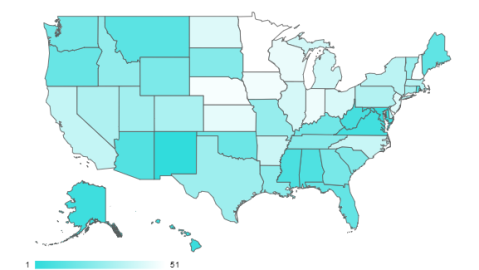The U.S. states hit hardest by the federal government shutdown

- A new map from WalletHub, generated by comparing various federal data, shows the states most affected by the government shutdown.
- About 800,000 federal employees are furloughed or are working without pay.
- Government shutdowns have become an increasingly common political tool, but it wasn’t until the early 1980s that they started resulting in the closing of federal agencies.
Friday marked the 21st day of the federal government shutdown, tying the record with the longest-running one in American history.
As a partisan battle over border security funding continues to grip the capital, about 25 percent of the federal government has been closed down, and some 800,000 federal workers are furloughed or working without pay. Some federal agencies had already received funding prior to the shutdown and have remained open, including Defense, Education, Veterans Affairs, Energy, Labor, Health and Human Services, Legislative branch and the Bureau of Reclamation.
Meanwhile, others have closed their doors, including Agriculture, Commerce, Justice, Homeland Security, Housing and Urban Development, Interior, State, Transportation and Treasury.
As the shutdown approaches three full weeks in length, some parts of the country are getting hit harder than others. A new map from WalletHub — generated by comparing metrics like share of federal jobs, federal contract dollars per capita, share of families receiving food stamps, real estate as a percentage of gross state product, and access to national parks — shows these discrepancies in full.
The data shows that:
- Red states are hit slightly harder than blue states.
- The District of Columbia, which employs about 20 percent of all federal employees, was hit the hardest.
- Alaska and Hawaii were among the top five hardest-hit states.
Some federal employees continue working
Federal workers who hold jobs deemed essential to the public are required to continue working, even without paychecks, such as Secret Service agents, Transportation Security Agents, pilots, air-traffic controllers and Border Patrol agents. These workers, after all, are legally prohibited from going on strike thanks to the Taft-Hartley Act passed in 1947.
“My personal opinion is that it constitutes involuntary servitude,” Eric Young, president of the union that represents the 30,000 employees of the Federal Bureau of Prisons, told The Atlantic.
Other federal workers are frustrated, too.
“Guess what happens this time of year — tuition bills. Property tax. Christmas credit cards,” Carl Houtman, an engineer who works for the Forest Service told USA Today. He recently protested the shutdown outside of the White House. “This is absolutely the worst time of year to miss a paycheck,” he added.
The origin and costs of government shutdowns
The federal government, or at least parts of it, shuts down when Congress fails to pass — or when the president refuses to sign — 12 so-called appropriation bills (or continuing resolutions) that lay out an annual budget for how government agencies will spend money in the next fiscal year.
Since 1974, the federal government has shut down 21 times. However, as Vox points out, it wasn’t until Attorney General Benjamin Civiletti issued a set of opinions in 1980 and ’81 that the government started treating “funding gaps” as necessitating the full or partial shutdown of government agencies. Now, government shutdowns cost the economy a lot of money.
For example, the financial ratings agency Standard & Poor’s estimated that the 16-day government shutdown of 2013 cost a total $24 billion, or some $1.43 billion per day, due to decreased travel, hotel bookings, park visits and lost labor.
“The bottom line is the government shutdown has hurt the U.S. economy,” Standard & Poor’s said in statement from 2013.





